Looking for a reliable code snippets plugin for WordPress? Then I’ve got some good news: we’re about to dive into a detailed review of WPCode.
I use custom code across several of our partner brands, so I know how powerful the right snippet can be.
But let’s face it – adding custom PHP, HTML, or CSS to your theme files can be a recipe for disaster. That’s why I built WPCode in the first place: to make it easy and safe to add snippets to WordPress.
I personally use WPCode across multiple websites, and I’m always impressed by its ease of use and flexibility. But just because I like something doesn’t mean it’s for everyone.
That said, in this WPCode review I’m putting it through its paces, exploring its features, testing out its support, and examining the various pricing plans. By the end of this WPCode review, you’ll know if it’s the right code snippet plugin for you. Let’s get started!

WPCode Review: Why Use It in WordPress?
Want to add custom features to your WordPress website without touching the theme files? WordPress is an open source website builder, which means you’re free to customize and extend its code.
While you can add custom code to the functions.php file, this isn’t very user-friendly. Plus, even a small mistake in the code could cause all sorts of common WordPress errors, or even break your site completely.
In 2012, I created a free plugin called Insert Headers and Footers. The goal of this plugin was to make it easy for me and other WPBeginner readers to add code to our WordPress site’s header and footer area without editing theme files.
But as time went on, I kept getting requests from users asking for more – like conditional loading of scripts on certain pages or the ability to add code snippets in different areas of their site. And that’s when the lightbulb moment hit: why not take Insert Headers and Footers to the next level?
The end result? WPCode.
WPCode can add custom CSS, PHP, HTML, and more to WordPress, without putting your site at risk. You can simply paste a snippet into WPCode’s code editor, and then activate it with the click of a button.
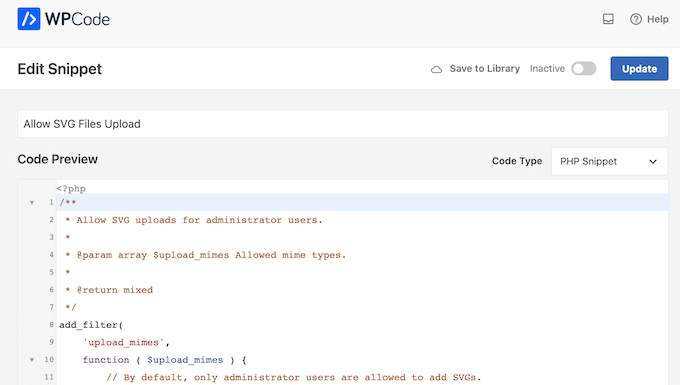
And don’t worry if you’re not sure where to start – WPCode comes with a library of 100+ ready-made snippets to get you going.
This includes a snippet that can completely disable comments, upload file types that WordPress doesn’t usually support, disable attachment pages, and much more.
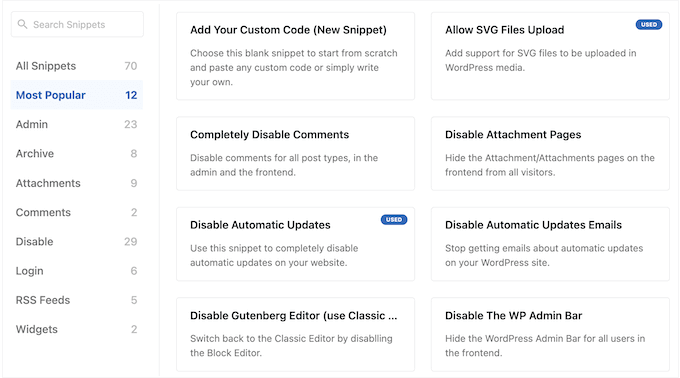
Plus, our plugin can automatically insert your code into the correct spot for you, so you don’t have to worry about messy theme files or complicated coding.
With WPCode, you can also create custom shortcodes. This is perfect if you want to control exactly where the code’s output appears inside a page, post, or widget-ready area.
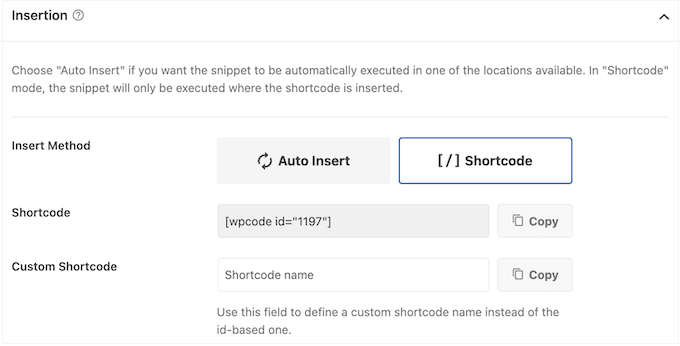
And the best part? You can download the free version of WPCode from the official WordPress repository.
This plugin has all the essential features, so you can add custom code to WordPress with ease. Even better, if you register for a free WPCode account then you’ll get access to 70 ready-made snippets.
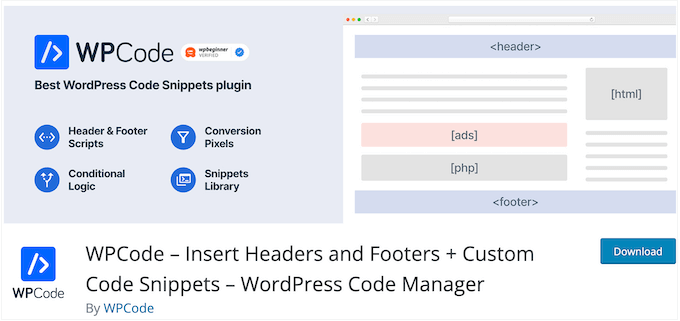
However, if you upgrade to the premium plugin then you’ll get access to more advanced features including smart conditional logic, revision history, and a code generator.
The premium WPCode also integrates with many of the plugins and services you may already be using on your website, including WooCommerce and Easy Digital Downloads. This means you can continue using your favorite tools, without having to worry about compatibility issues or integration headaches.
WPCode Review: Is It The Right Code Snippet Plugin For You?
I’ve tried various different code snippet plugins over the years but let me tell you: they’re not always easy to use. Some are even missing crucial features.
When I set out to expand our free plugin, I knew that WPCode had to be more than just another snippets plugin. I wanted it to be a full-featured code snippet management solution – and I think we succeeded. But the question remains: does WPCode have everything YOU need?
To find out, let’s take a closer look at all WPCode’s features in detail. From conditional logic to auto-insertion, I’ll help you decide if it’s truly the ultimate solution for your WordPress site.
1. Safely Add Custom Code to WordPress
Remember those guides that tell you to edit your site’s functions.php file? Yeah, don’t do that! It’s a recipe for disaster. Not only can it break your site, but you’ll also lose all your custom code the next time you update your theme.
With WPCode, you can add custom code to WordPress without ever touching your theme files or creating a child theme. And if something goes wrong, you can disable the problematic snippet with a click of a slider.

The best part? WPCode takes care of everything for you, so you can also update your WordPress theme without losing your customizations. And if you ever change your WordPress theme, WPCode will automatically apply all your custom snippets – it’s like magic!
How I Use It: WPCode has made adding custom code to our various sites incredibly easy and safe. We can now add custom code snippets with confidence, knowing they won’t cause any problems.
2. Over 100 Ready-Made Code Snippets
WPCode comes with over 100 pre-built code snippets that you can access directly from the WordPress dashboard.
No more copying and pasting code, or wasting time scouring the web for the perfect snippet.
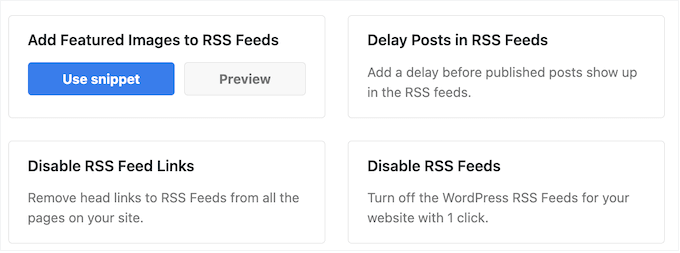
The WPCode team has carefully selected these snippets to cover all the most common WordPress tasks. Need to disable the REST API? Done! Want to duplicate posts in a single click? Easy peasy! Want to disable lazy load in WordPress? No problem!
The best part? These snippets are pre-configured with all the right settings, so you can just add them to your site.
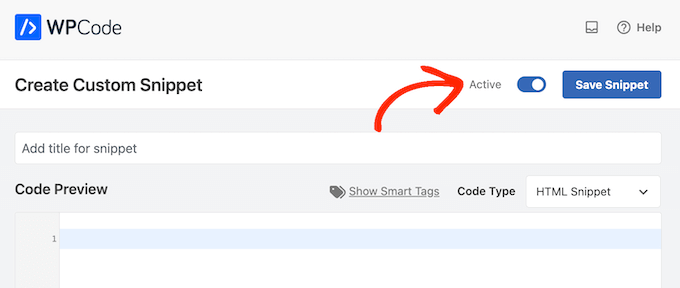
My Honest Thoughts/Review: I can imagine these ready-made snippets saving users a TON of time. If you’re looking for a way to speed up your WordPress development process, give WPCode a try – it’s worth every cent.
3. Create Your Own Custom Code Snippets
WPCode isn’t just about pre-built snippets – it’s also a super-powerful code editor that lets you create your own custom code from scratch. Simply paste or type away, and WPCode will take care of the rest.
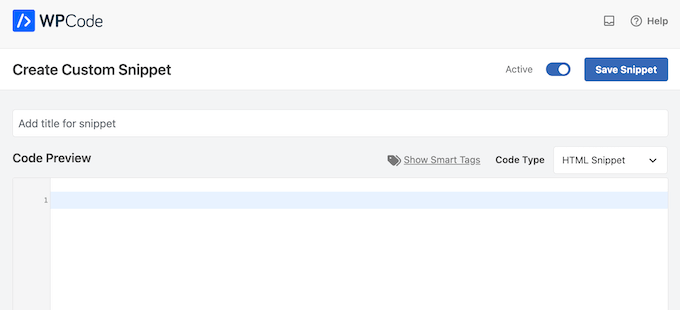
We support all the major languages, including PHP, JS, CSS, and HTML, so you can add just about any kind of snippet to WordPress. Want to add some custom functionality? Go for it! Need to tweak a specific part of your site’s code? Easy!
And when you create your own snippets, you’ll get access to all the standard WPCode settings, like scheduling, smart conditional logic, and more. This means you can fine-tune every detail, so your custom code works exactly how you want it to.
My Honest Thoughts/Review: I love how easy it is to create custom code snippets with WPCode. I can create my own snippets and reuse them across different projects, saving a ton of time and effort.
4. Replace Multiple WordPress Plugins with Code Snippets
When you need to customize WordPress or add a missing feature, you’ll typically install a WordPress plugin. However, there are many tasks you can perform by using a code snippet instead.
Installing too many plugins can slow down your site, hurt your WordPress SEO, and make it more vulnerable to bugs, security issues, and software conflicts.
WPCode can actually reduce plugin clutter on your WordPress blog or website. Instead of installing a new plugin for every task, you can use code snippets to get the job done.
How I Use It: I’m really glad we started using WPCode across our own websites. It’s helped us reduce our plugin overhead, so everything just runs smoother.
5. Auto Insert Code Snippets
We’ve all been there – trying to figure out where to add custom code in our files, only to resort to using trial and error.
But not with WPCode. This plugin has got your back by making it ridiculously easy to insert code snippets exactly where you need them. Just scroll down to the ‘Insertion’ box, choose from our dropdown menu, and you’re done.
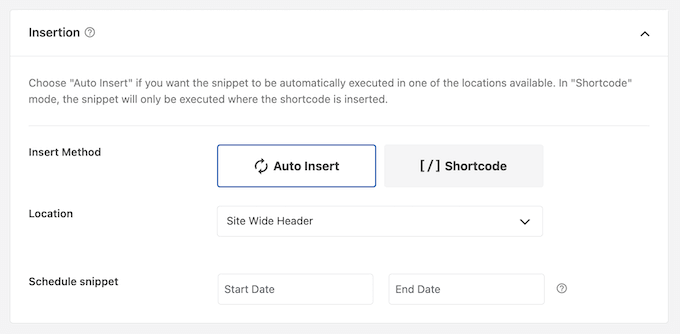
You can also insert code into your site wide header, footer, or body.
This is a good choice if you’re adding scripts for Google Analytics, Google AdSense code, or Facebook pixel.
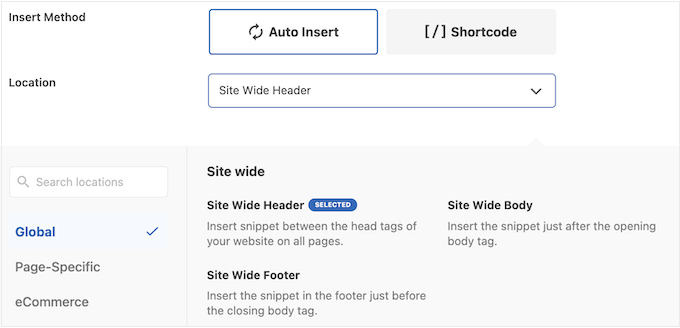
If you need to be more specific, then you can tell WPCode to insert the snippet before or after a particular element. For example, you can add it before a certain HTML element.
With WPCode, you have total control over where that code loads on your site. No more guesswork, no more frustration.
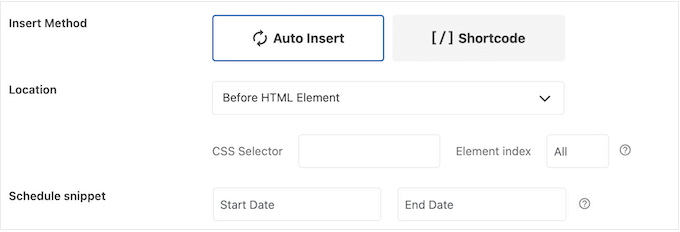
My Honest Thoughts/Review: I’m blown away by just how convenient WPCode’s auto-insert feature is!
6. Create Custom Shortcodes
Let’s face it, WordPress’ shortcodes are a complete game-changer. They make it ridiculously easy to add dynamic content to your posts, pages, and widget-ready areas.
And the best part? Many plugins and themes come with their own shortcodes, so you can jazz up your site with specialized things like contact forms, galleries, and responsive sliders.
But here’s the thing: you don’t have to stop at pre-made shortcodes. With WPCode, you can create your very own custom shortcodes. Need to display a copyright notice on every page? Boom! Done. Want to add a Google AdSense banner that updates dynamically? Easy peasy!
And with WPCode, creating these custom shortcodes is a breeze. Just paste the code into the editor, and we’ll take care of the rest.
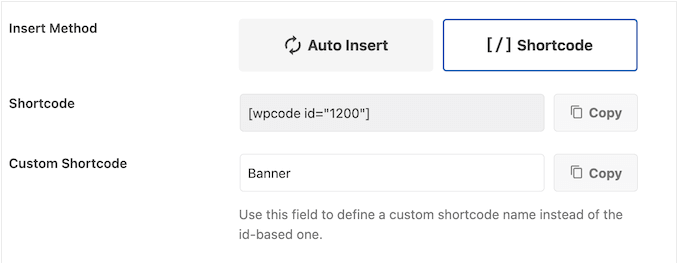
If you’re using one of the newer, block-enabled themes, then you can even add your custom WPCode shortcodes using the full-site editor.
In this way, you can add powerful custom scripts, content, features, and more to your theme including areas that you can’t edit using the standard WordPress content editor.
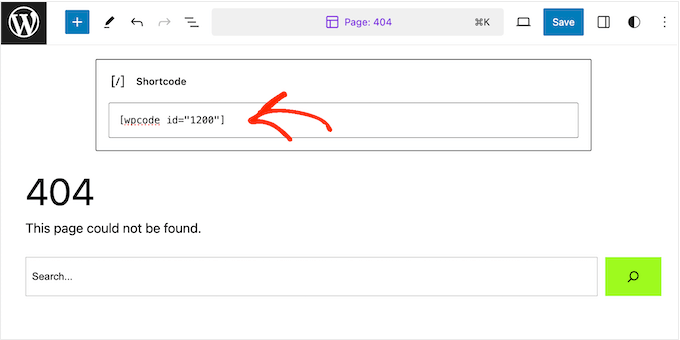
But here’s where it gets really cool: with WPCode, you can also update those original codes in one place, and every shortcode will load the latest version automatically. No more tedious editing or updating multiple instances.
My Honest Thoughts/Review: WPCode makes it easy to create custom shortcodes for your website. Add custom functionality to our site without writing complex code every time? What’s not to love!
7. Safe Error Handling and Notifications
We’ve all been there – a pesky code error brings your site to its knees, and you’re stuck troubleshooting for hours. But not with WPCode!
This plugin automatically scans your snippets for errors. If WPCode detects a problem, then it’ll deactivate the snippet straight away. It’ll also show some information about the problem, so you can troubleshoot the error and fix it as quickly as possible.
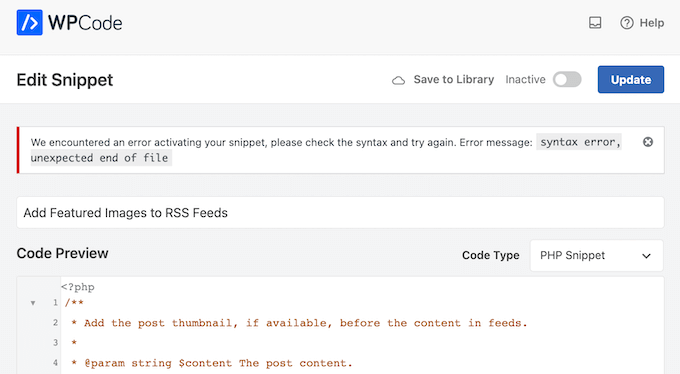
No more worrying about broken code or losing access to your site. With WPCode, you can relax knowing that our error-scanning magic has got your back.
How I Use It: WPCode’s error handling and notification system gives me complete peace of mind. We can now detect and fix errors before they become major issues.
8. Schedule Snippets
Managing code snippets can be a real time-drain, especially when you’re running a busy website or juggling multiple client sites. But with WPCode, we’ve got a solution that’ll save you hours of hassle.
Our scheduling feature lets you add start and end dates to your code snippets, so they go live (or offline) automatically at the right time. It’s perfect for limited-time offers, promotions, or special events – just set it and forget it.

And if you’ve got a bunch of snippets to manage, WPCode makes it easy to prep them all in advance and schedule them to go live when you need them to. No more manual updates or last-minute scrambles.
Plus, our scheduling feature is a total lifesaver for client managers out there. You can prepare all your snippets ahead of time, so you can focus on what matters most: delivering amazing results for your clients.
My Honest Thoughts/Review: This is the perfect example of a simple feature that opens up a world of possibilities. Plus, you can focus on more strategic tasks, knowing that your code snippets are being executed at the right times.
9. Target Smartphones, Tablets, or Desktop Computers
One of the coolest things about WPCode is that it lets you tailor your custom code snippets to specific devices – yes, you can create different versions for smartphones, tablets, and desktop computers.
Think about it: mobile devices are all about speed and simplicity. So why not optimize your code snippets for those devices? With WPCode, you can easily disable non-essential scripts on mobile devices, ensuring that your site loads quickly and smoothly.
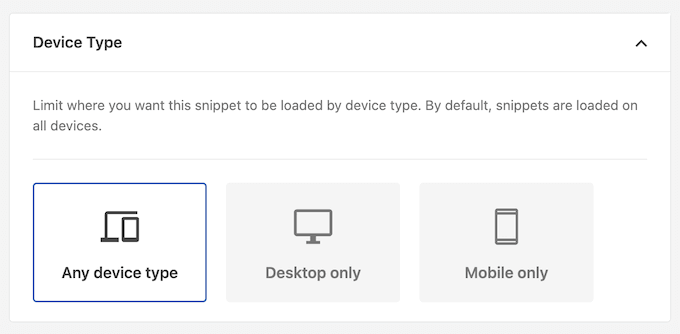
But here’s the best part: with our plugin, you’re not limited to just one device-specific version of each snippet. You can create multiple variations, optimized for different devices or even specific use cases. Want to show a special promo to tablet users? Done! Need to disable a script on desktop computers? Easy peasy!
My Honest Thoughts/Review: With WPCode, you can give every visitor an amazing experience, no matter what device they’re using.
10. Smart Conditional Logic
You may not want to use a particular code snippet on every single page and post.
That’s where WPCode’s smart conditional logic comes in. With our intuitive rules builder, you can control exactly when your snippets load without having to write a single line of complex code. Want to show a snippet only on specific pages and posts? No problem!
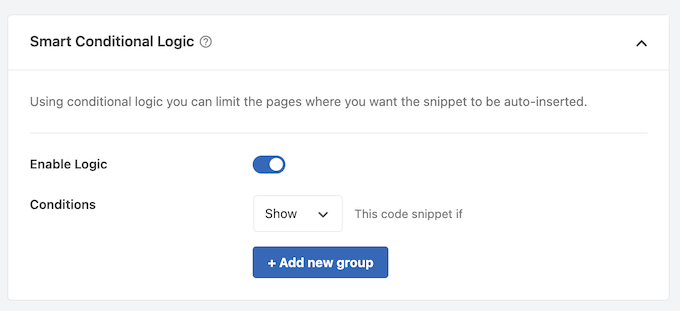
You can use the conditional logic rules builder to only load snippets on specific posts and pages. In this way, you can avoid loading unused scripts that might impact your site speed and hurt your WordPress SEO.
In particular, marketing and tracking scripts can sometimes negatively impact a site’s performance, so you’ll want to avoid loading them on every single page and post.
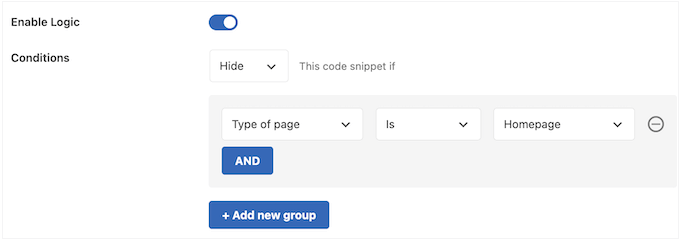
But that’s not all – our conditional logic lets you get really granular with your snippet deployment.
Load different scripts based on user roles? Easy! Show exclusive features or content to logged-in users on your membership website? Done!

It’s also possible to load different snippets based on the date and time.
This can be a way to keep your site fresh and interesting, even for regular visitors.
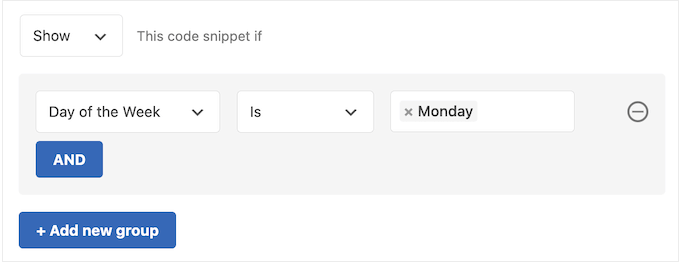
But here’s the cherry on top: our conditional logic rules are specifically designed with popular platforms like WooCommerce and Easy Digital Downloads in mind.
Want to add a snippet to the WooCommerce checkout page? No problem! Need to set up conversion tracking without writing complicated code? Easy!
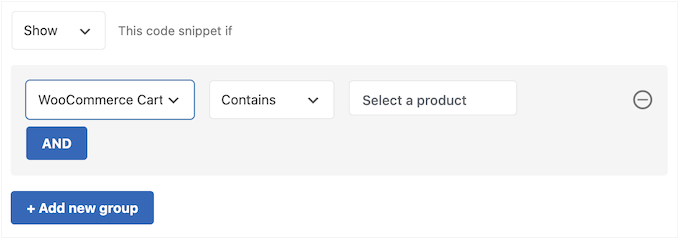
My Honest Thoughts/Review: This was a feature our community really wanted, and we listened! If you’ve been looking for a way to implement advanced logic in your WordPress development, then this is the feature for you.
11. Code Revision History
As I already mentioned in this WPCode review, there’s a single dashboard where you can see all your code snippets. From here, you can manage all your code snippets with ease – enable, disable, or edit them with just a few clicks.
But what really sets WPCode apart is its revision history feature. Whenever you make changes to your snippets, we create an automatic backup of the previous version. This means you can always revert to an earlier version if something goes wrong – no more stress or lost work!
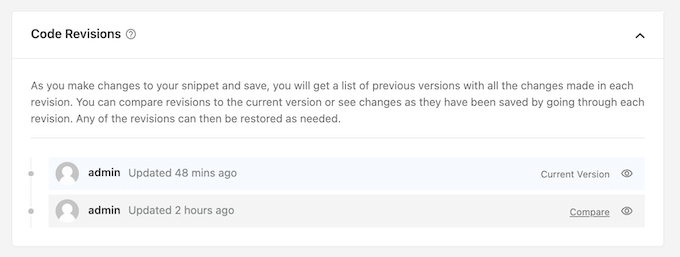
WPCode doesn’t just record changes to the code itself. It also logs changes to the settings, including any edits you make to the smart conditional logic, code type, auto-insert locations, and more.
To see a revision, simply click on its ‘Compare’ link. This will open the WPCode revision editor, which is similar to the built-in WordPress post revision tool.
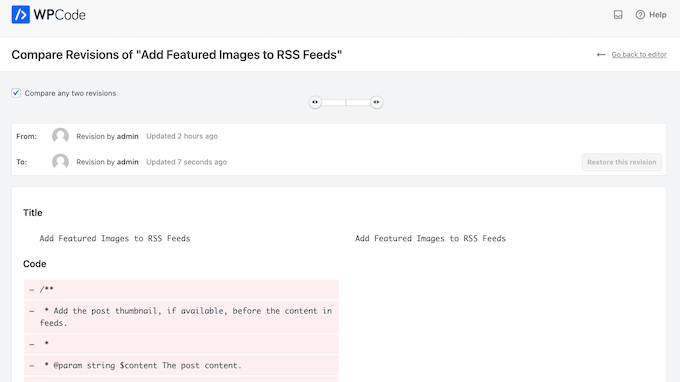
Here, you can compare this revision to the current version. You can also revert to an earlier revision with the click of a button. This feature is invaluable if you make a mistake and need to restore a working version of the snippet.
WPCode’s revision history is also perfect for experimenting with different settings or configurations. Want to try out a new approach? No problem! Just make the changes, see how it goes, and if you don’t like it, simply revert back to the previous version.
With WPCode, you can work on your code snippets with complete peace of mind, knowing that our revision history has got you covered.
My Honest Thoughts/Review: The code revision history isn’t just a feature; it’s a safety net. Knowing we can track every modification and revert if necessary has removed the worry that used to come with custom code.
If you’ve ever hesitated to add code because of the ‘what ifs,’ WPCode eliminates that fear.
12. Store Snippets in a Private Cloud
If you’re a WordPress pro who manages multiple sites, then you may need a way to share code between them. Our plugin lets you store all your custom snippets in a private cloud that you can access directly from your WordPress dashboard.
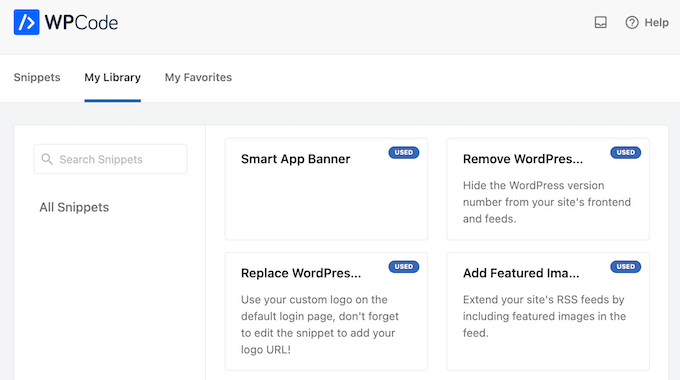
This means you can share code between multiple sites with ease, and even create a backup of important snippets just in case. Even if you accidentally delete a snippet from one site, you can still access it in the library.
But here’s the best part: WPCode saves each snippet’s settings to your private cloud, so you only have to configure smart conditional logic and other important settings once.
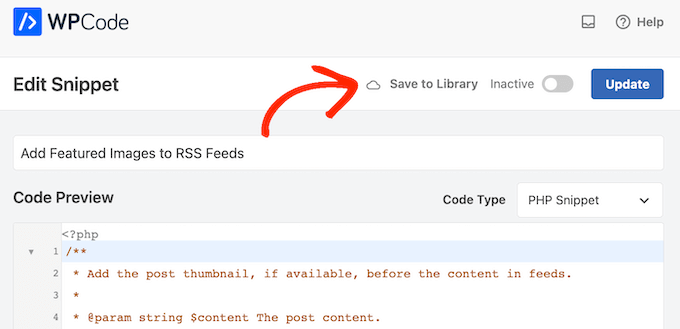
This is a total game-changer for WordPress development agencies – just imagine being able to set up new client sites in a fraction of the time it takes now.
And with our library, you can connect it to any client site, work your magic, and then disconnect when you’re finished. No more worrying about giving clients access to your private library – WPCode’s got that covered.
My Honest Thoughts/Review: With WPCode, sharing code snippets across multiple sites has never been easier or more efficient. Say goodbye to duplicate code and hello to streamlined workflows.
13. Beginner-Friendly Code Generator
Do you want to create your own snippets, but don’t know how to code?
WPCode has a built-in code generator that allows you to create snippets, simply by completing a form.
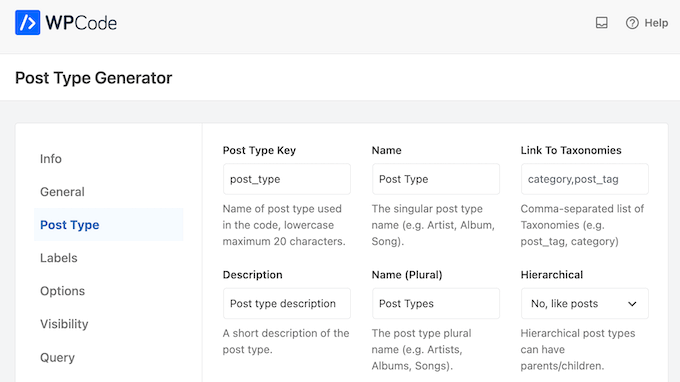
Just type in some information about what you want to achieve, and WPCode will generate clean, error-free code to suit your needs. For example, imagine you want to create a custom post status to improve your editorial workflow.
To start, simply select WPCode’s Post Status generator.
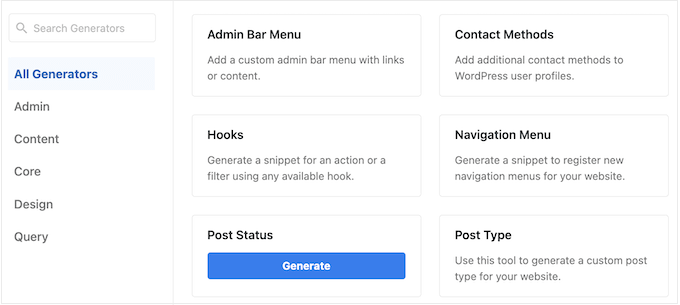
You can then type in a name for the status, decide whether it should appear on your site’s frontend, exclude or include it in the search results, and configure other important settings.
When you’re happy with the configuration, click on Generate Code.
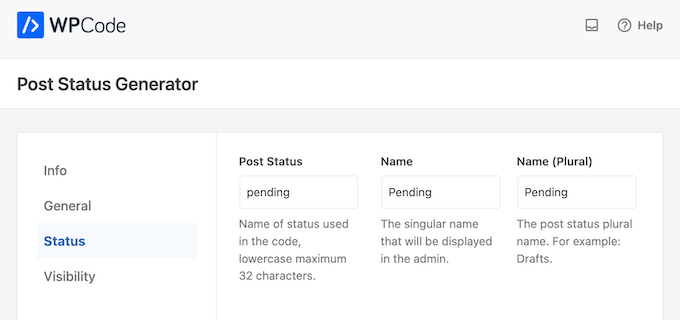
WPCode will then create some custom code based on your exact settings. That done, you can go ahead and add the snippet to WPCode, and start using the custom post status.
My Honest Thoughts/Review: Creating complex code snippets used to be time-consuming, but this feature makes it a breeze – even if you don’t know how to code!
14. AI Code Snippet Generator
Want an even easier way to create custom snippets without learning how to code? Of course you do!
WPCode now comes with a powerful AI (artificial intelligence) snippet generator. Simply type a description of what you want the code to do, and the AI will instantly generate the snippet for you.
To get started, select the ‘Generate snippet using AI’ option when adding a new snippet.
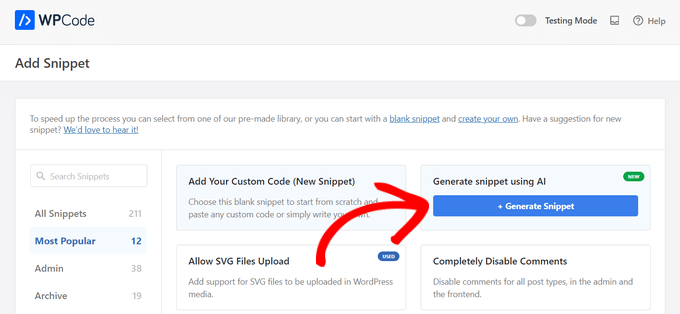
After that, a text box will pop up where you can type what you want the snippet to do.
As you can see, I used ‘add a thank you note on the checkout page for logged-in users’ for my prompt. Then, click the ‘Generate’ button.

WPCode will automatically write the new code snippet, as well as select the auto-insert location and set conditional logic, if needed.
You can then add this snippet to WPCode and start using it right away – no coding skills required!
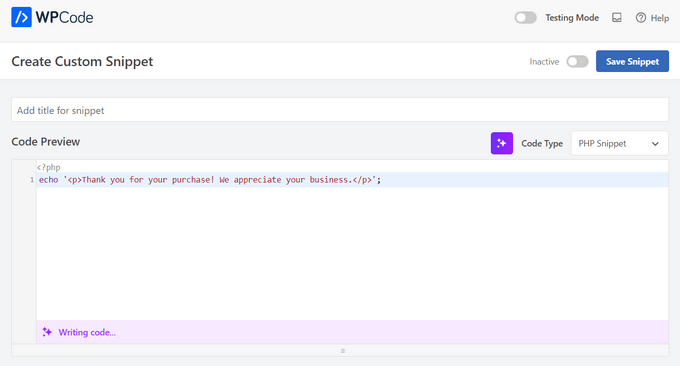
If the snippet isn’t quite right and you want to make adjustments, you can click on the ‘AI Improve’ button and describe the changes you want to make.
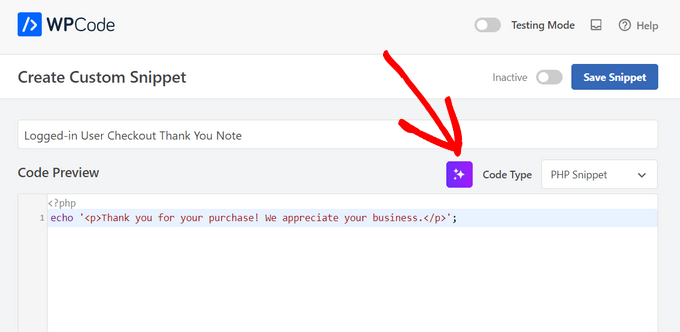
You can also use the AI improve feature to make your existing code snippets even better.
My Honest Thoughts/Review: This is a big one, and I’m convinced these kind of AI-powered features have the potential to completely change how we write custom code in WordPress.
15. Import and Export Code Snippets
Imagine setting up a new online store or blog and not having to recreate all the snippets from scratch. With WPCode’s import/export feature, you can easily share your custom code snippets across all your sites.

And if you’re switching from an alternative snippets plugin like Woody Code Snippets or Code Snippets Pro, we’ve got you covered too!
WPCode makes it easy to import snippets from other plugins.
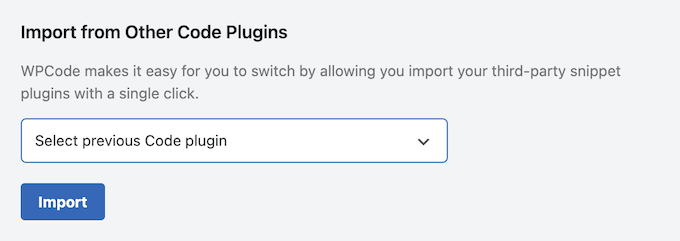
Thanks to this import/export, you can benefit from all of WPCode’s advanced features, without having to manually recreate snippets you created using an alternative plugin.
My Honest Thoughts/Review: No more tedious manual recreation – just import and go! With WPCode’s import/export feature, you’ll save a ton of time and can focus on what really matters: creating amazing websites!
16. Access Controls
By default, only admin users have permission to edit your WPCode snippets. However, sometimes you may want to grant access to other users.
Maybe you’ve got editors who need to create PHP snippets for the posts and pages they’re working on. Or perhaps you’ve created a custom user role in WordPress and want to make that person responsible for managing your code.
That’s where WPCode Pro and Elite come in. These versions of our plugin include built-in access controls, so you can give non-admin users permission to manage your WPCode code snippets.
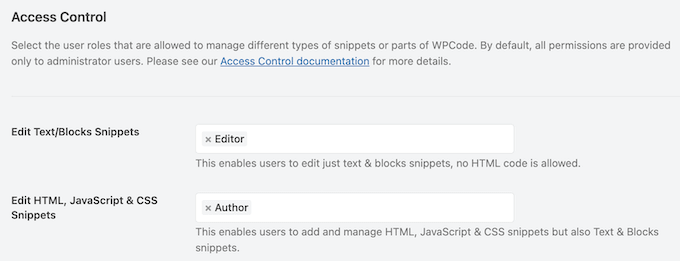
My Honest Thoughts/Review: WPCode’s access controls makes it easier to manage your code snippets. This becomes absolutely crucial, as you add more and more snippets to your site.
17. Professional and Community Support
WPCode makes it super easy to add custom code snippets to your WordPress blog or website, but we know sometimes you might need a little extra guidance. That’s why we’ve got a whole arsenal of resources at your fingertips.
First, there’s our detailed online documentation – perfect for those who like to dive in and figure things out themselves.
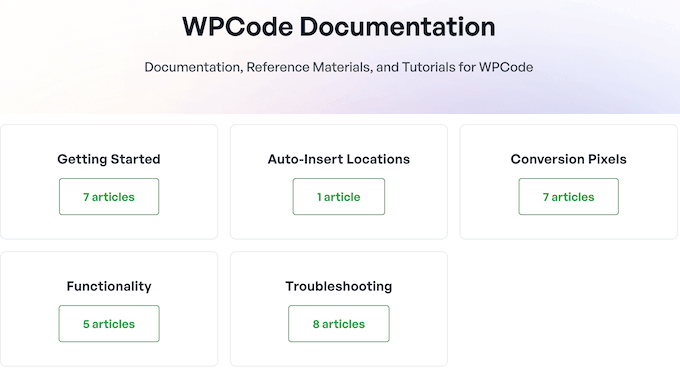
And if you’re still stuck, don’t worry. Our WPCode blog is packed with step-by-step guides covering everything from how to use specific plugin features, right through to general advice such as how to customize your WordPress header using code.
Whether you’re a free user or premium licensee, you’ll have access to all these resources, so you can get the help you need whenever you need it.
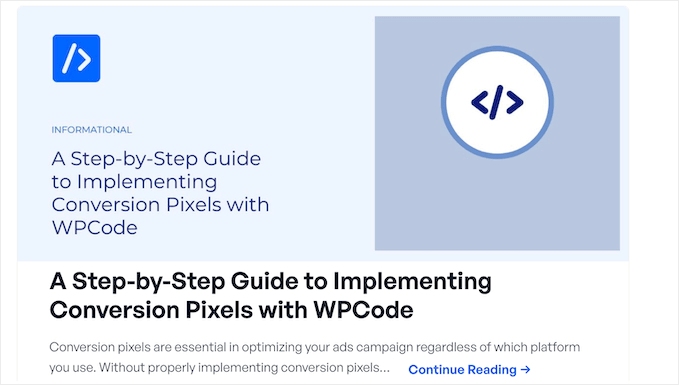
And if you do decide to upgrade to a premium license, you’ll get access to our top-notch support team.
Simply raise a support request in your account, and a member of the WPCode team will respond within 24 hours, Monday-Friday.
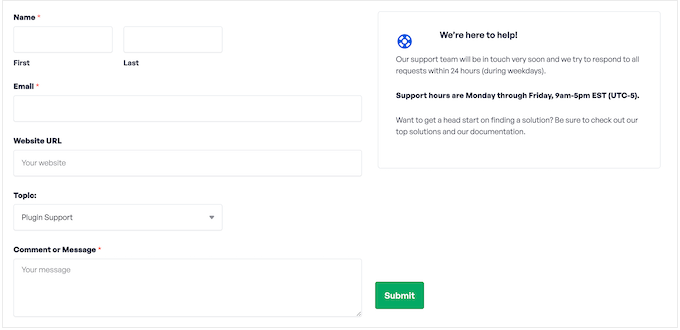
WPCode Review: Pricing and Plans
Looking for a free plugin to paste snippets from the web into WordPress?
WPCode Lite is the way to go! But if you want to access the full code library or unlock more powerful features, then you’ll need to upgrade to the premium plugin.
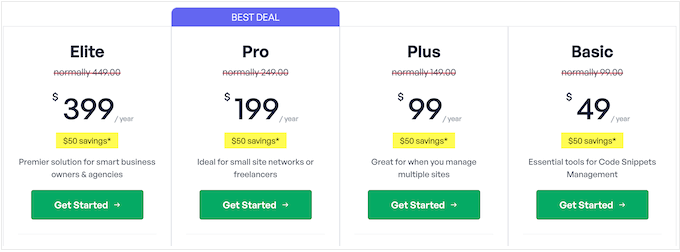
All the premium WPCode plans give you access to over 100 expert-approved code snippets. However, there are some key differences:
- Basic. For just $49 per year, you can access our private cloud library, where you can store snippets for easy access anywhere, anytime. You can also see the complete revision history for all your snippets, schedule your code, and manage your ads.txt file directly from the WordPress dashboard.
- Plus. Priced at $99 per year, the Plus plan comes with our Conversions Pixel addon – a game-changer for retargeting campaigns. With this feature, you can easily add tracking pixels for popular platforms like Facebook, Pinterest, Google Ads, and TikTok.
- Pro. For $199 per year, WPCode Pro gives you built-in access controls. This means you can give non-admin users permission to edit and add code snippets to your WordPress site – perfect for multi-author blogs and teams.
- Elite. Priced at $399, you can use WPCode Elite on up to 1,000 websites. This makes it the perfect choice for WordPress development agencies, or anyone who manages a list of client websites.
WPCode Review: Is it Worth It?
To conclude this in-depth WPCode review, I’m confident that it’s the best code snippets plugin for WordPress. It allows you to add custom code to your website without editing your theme files or using complicated tools such as an FTP client.
If you run an online store or sell digital downloads, then I highly recommend WPCode Plus. This plan adds conversion pixel code to your site automatically, so you can track customers and conversions with ease, and optimize those ad campaigns for maximum ROI.
But what if you’ve got a team of people working on your WordPress site? No problem! The Pro plan includes access control settings – ideal if you’re working in a team.
Finally, Elite is an affordable plan for WordPress developers and agencies. With this single plan, you can use WPCode on up to 1,000 websites. That means you can quickly and easily add custom code snippets to all your client sites, saving you time and hassle in the long run.
I hope this WPCode review helped you decide whether it’s the right code snippets plugin for you. You can also check out our guide on how to create a landing page with WordPress, or see our expert pick of the best AI chatbot software.
If you liked this article, then please subscribe to our YouTube Channel for WordPress video tutorials. You can also find us on Twitter and Facebook.



Giri
WPCode is one of the fantastic plugins. I have been using it for months and getting a lot of benefits. It has reduced the plugin numbers, easy to add code, code will be perm even after WP upgrade. Especially no need to touch the core code, no need to worry about coding. Just like that, we can use it. Its an amazing plugin. I strongly suggest using it.
Kaushal sa
BEST FOR WORDPRESS
Achraf Hebboul
WPCode is a beneficial plugin because it prevents users from directly interacting with the theme to add custom code, which is bad since it can result in code that opens vulnerabilities in websites or corrupts the theme codebase.
A brief note to the reader of this comment: if you are certain that you will add custom code to your WordPress website, make sure you get in touch with someone who is familiar with the WordPress codebase, or if you choose to do it yourself, try not to add any code that could damage your website. Secondly, if you want to perform database operations, don’t use SQL queries straight away; instead, make sure you first try to find a function from WordPress Codex that you can rely on it